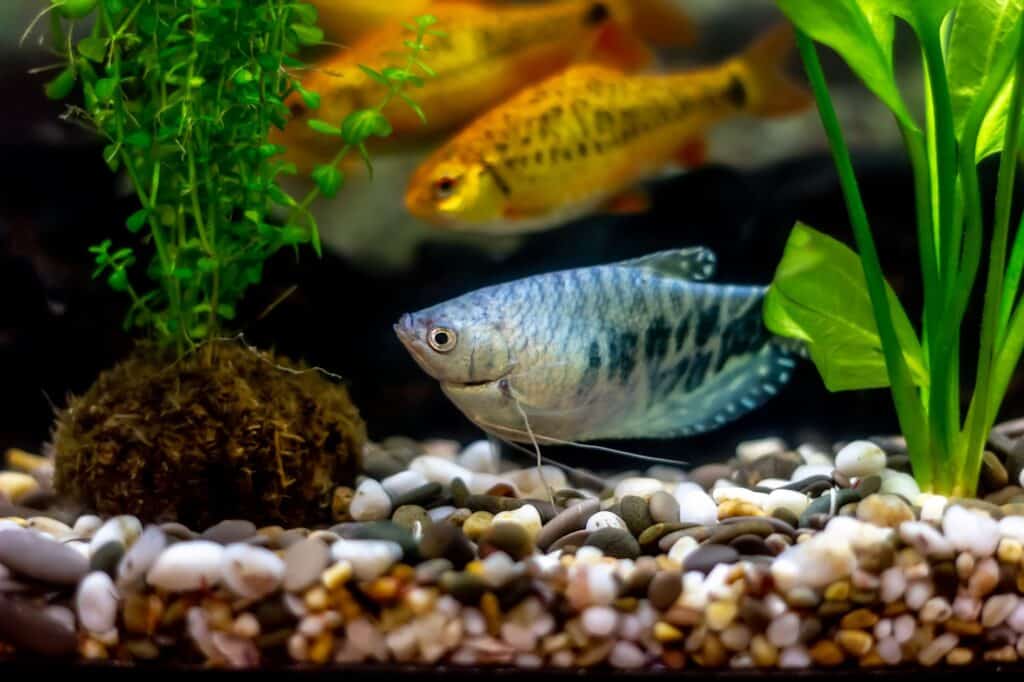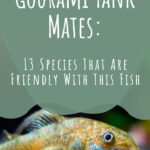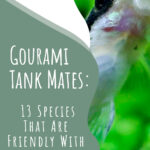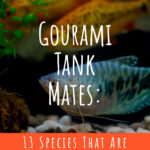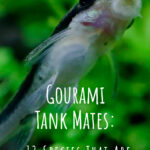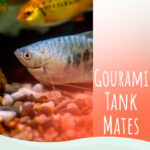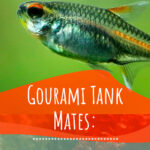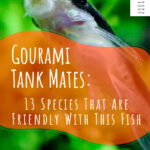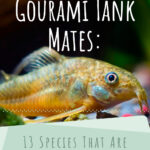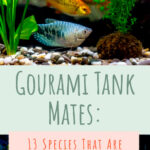The gourami has long been a favorite fish for the home aquarium for many reasons. There are lots of different gourami varieties to choose from, they’re easy to care for, don’t get too big (depending on the species), and make excellent community fishes. What’s not to like?
In this detailed guide, we check out 13 ideal gourami tank mates so you can enjoy these vibrant, active fishes in a community aquarium setup.
But first, let’s introduce the gourami family of fishes.
Gourami Overview
Before you can choose suitable tank mates for your gourami, you need to know more about the species so you can pick other species that share the same basic requirements.
Labyrinth organ
Gourami fish belong to the Anabantidae family of labyrinth fish. All the fish in this group have a specialized labyrinth organ that enables the fish to breathe air at the water surface. In the wild environment, the labyrinth organ allows the fish to live in oxygen-depleted water so that they can survive the dry seasons.
If you see your gourami occasionally taking gulps of air at the surface, don’t panic! That’s perfectly normal behavior and shows that your fish are content and happy in their tank. However, if the gouramis are hanging listlessly at the surface, there could be a problem with your water quality, so check that ammonia, nitrites, and nitrate levels are within acceptable parameters and carry out a partial water change if necessary.
What’s the gourami’s natural habitat?
Gourami fish are native to southern and eastern Asia, ranging from Pakistan through Vietnam, Thailand, China, Malaysia, and north and east to Japan and Korea.
The climate here is tropical, and the fish live in slow-moving bodies of water, temporary pools, wetlands, swamps, and marshes.
Water parameters
In nature, most gouramis live in soft, acidic water. Still, commercially raised aquarium fish are accustomed to living in water that is more alkaline and has a higher pH than their native habitat. Ideally, the water pH should be in the range of 6.8 to 7.8, water hardness between 3 and 8 dKH, and a water temperature of between 75° F and 80° F.
Although wild gourami fish often live in stagnant water, the aquarium should be properly maintained with an efficient filtration system, and you should carry out partial water changes of 10 percent weekly or 25 percent every two weeks. You’ll also need to vacuum the substrate every week to remove fish waste, decaying plant matter, and uneaten food.
Tank requirements
Gouramis come in different sizes. For example, Sparkling, Honey, Croaking, and Dwarf Gouramis are very small and can be comfortably housed in a 10-gallon tank. Larger species, like Opaline, Pearl, and Moonlight Gourami fish, need spaces that are 30 gallons or larger. Kissing Gouramis can grow to be pretty large and need a 55-gallon aquarium or larger to be comfortable. And if you take on Giant Gouramis, you’ll need a 250-gallon tank as a minimum, as these bad boys can reach 24 inches long when fully grown.
Your tank should have a cover slide and a tightly fitted lid, as gouramis can and do jump!
Most gourami species tend to gravitate to the water surface and are not especially active swimmers. So, a shallower, rectangular container with lots of dense planting, driftwood, and rocks is ideal. Bear in mind that the more suitable the tank, the better the fishes’ colors will be, as they will be relaxed and secure in their home.
Remember that chilled out fish are much less likely to succumb to the effects of stress, typically enjoying better health and living for longer.
Are gouramis aggressive?
Although gouramis are not aggressive fish, males can become belligerent toward each other. However, I have a small group of male Cobalt Blue Dwarf Gouramis together with a couple of females, and the community is harmonious with no signs of aggression at all.
Gouramis are quite slow-moving creatures, and they will fall victim to fin nippers and large, aggressive types. So, keep that in mind when selecting ideal tank mates, and look for peaceful fish species as a companion for your gouramis.
Gourami diet
Most gouramis are omnivores, thriving on a diet of tropical fish flakes, granules, frozen meaty food, and live foods for an occasional treat. However, Kissing Gouramis are herbivorous and should be fed suitable commercially prepared foods, supplemented with blanched veggies occasionally for variety.
What are good gourami tank mates?
Now that you know more about the different species of gourami and their optimum tank requirements, you can look for tank mates with similar needs. Here are 13 suggestions for fish and invertebrates that will get along swimmingly with your gourami.
Corydoras Catfish
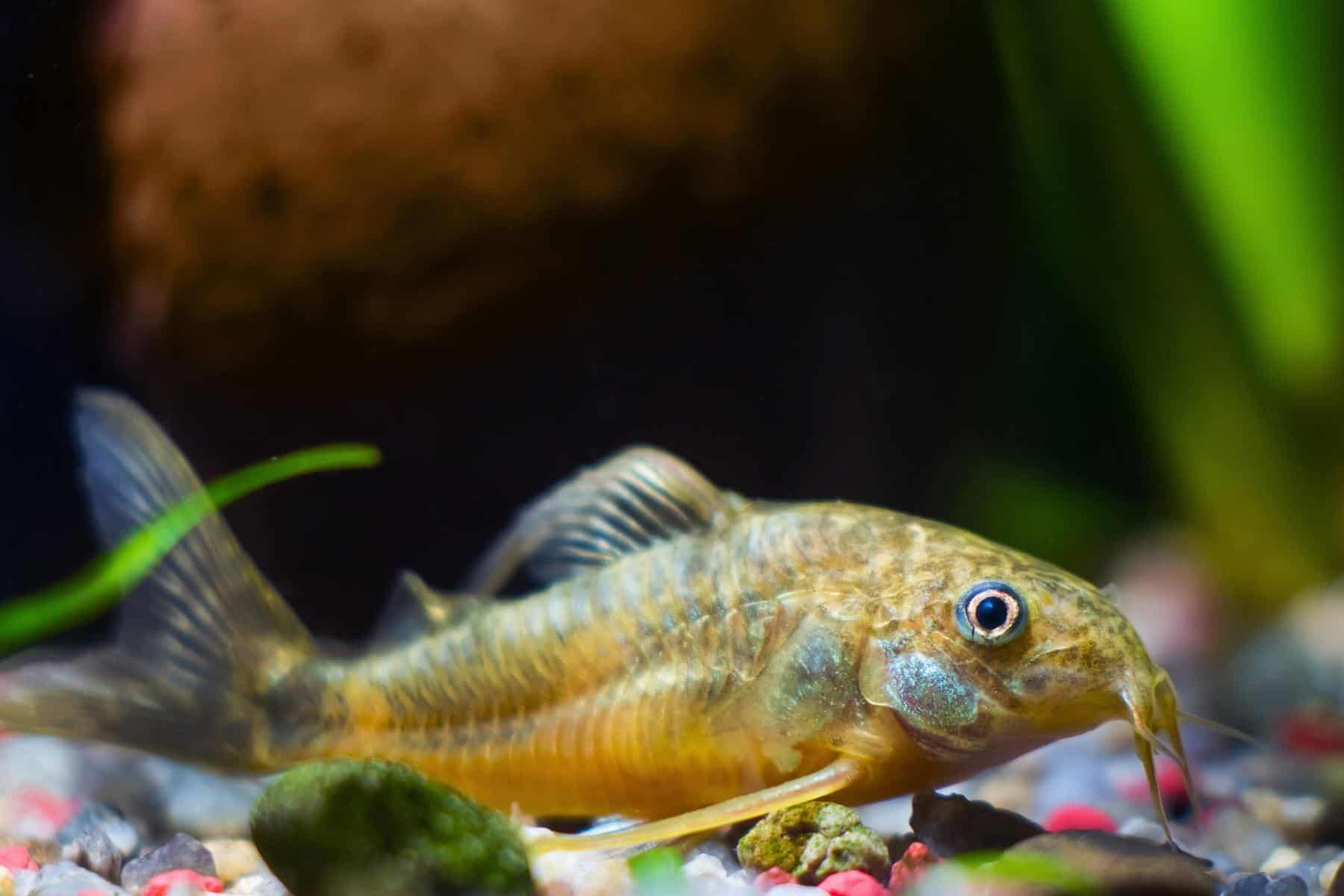
- Care level: Easy
- Temperament: Peaceful
- Tank size: 15 gallons
- Size: 2-4 inches
- Life expectancy: up to 7 years
The Corydoras Catfish is a firm favorite with many hobbyists. These cute little armored catfish are peaceful bottom-dwellers, spending much of their time foraging around the substrate and the bottom of the tank hunting for scraps of food or resting in small groups.
There are lots of different varieties of corydoras to choose from, all of which are extremely hardy and easy to care for. Corys are omnivores that have similar water preferences to gouramis and will be happy in a well-planted environment. Corys do best on a sandy or fine gravel substrate that won’t damage their delicate barbels.
Harlequin Rasboras (Trigonostigma heteromorpha)
- Care level: Easy
- Temperament: Peaceful
- Tank size: 15 gallons (rectangular)
- Size: 1 inch
- Life expectancy: 2-3 years
Harlequin Rasboras are delightful little schooling fish that will bring color and activity to your aquatic community. These fish share the same aquarium conditions as gouramis — soft, acidic water with a warm temperature. And they’re peaceful, too!
These fish live in streams where the water is slow-moving, and the light is diffused by overhanging vegetation. Harlequin Rasboras appreciate a well-planted aquarium with lots of hiding places.
Pygmy Corydoras (Corydoras pygmaeus, hastatus, habrosus)
- Care level: Easy
- Temperament: Peaceful
- Tank size: 10 gallons
- Size: 1 inch
- Life expectancy: 2-3 years
Related to the regular corydoras catfish, the Pygmy Corydora is a miniature version of its cousin. There are three varieties of Pygmy Corydoras to choose from, all of which do very well in a community with gouramis.
Except for Corydoras pygmaeus that does frequent the middle of the water column, these active little fishes live on the bottom of the aquarium, darting up to the surface periodically for a gulp of air. Pygmy Corys are lively creatures that provide plenty of interest in the tank, but you must keep them in large groups, ideally of at least ten individuals.
Also, be sure to offer them plenty of hiding places by adding driftwood, caves, and rockwork to the setup.
Mystery Snail (Pomacea bridgesii)
- Care level: Easy
- Temperament: Peaceful
- Tank size: 15 gallons
- Size: 1 inch
- Life expectancy: 1-2 years
Snails are an attractive and helpful addition to any aquarium where the mollusks keep busy by eating algae and grazing on decomposing plant debris. Mystery snails are a type of Apple snail, but these brightly colored little guys won’t eat your plants, and they stay smaller, too.
Mystery snails are completely peaceful, and they’re also big enough to ignore the attention of curious gouramis. These fascinating creatures make a fun addition to the tank. They come in lots of different colors, too, including purple, yellow, white, and blue.
Glowlight Tetra (Hemigrammus erythrozonus)
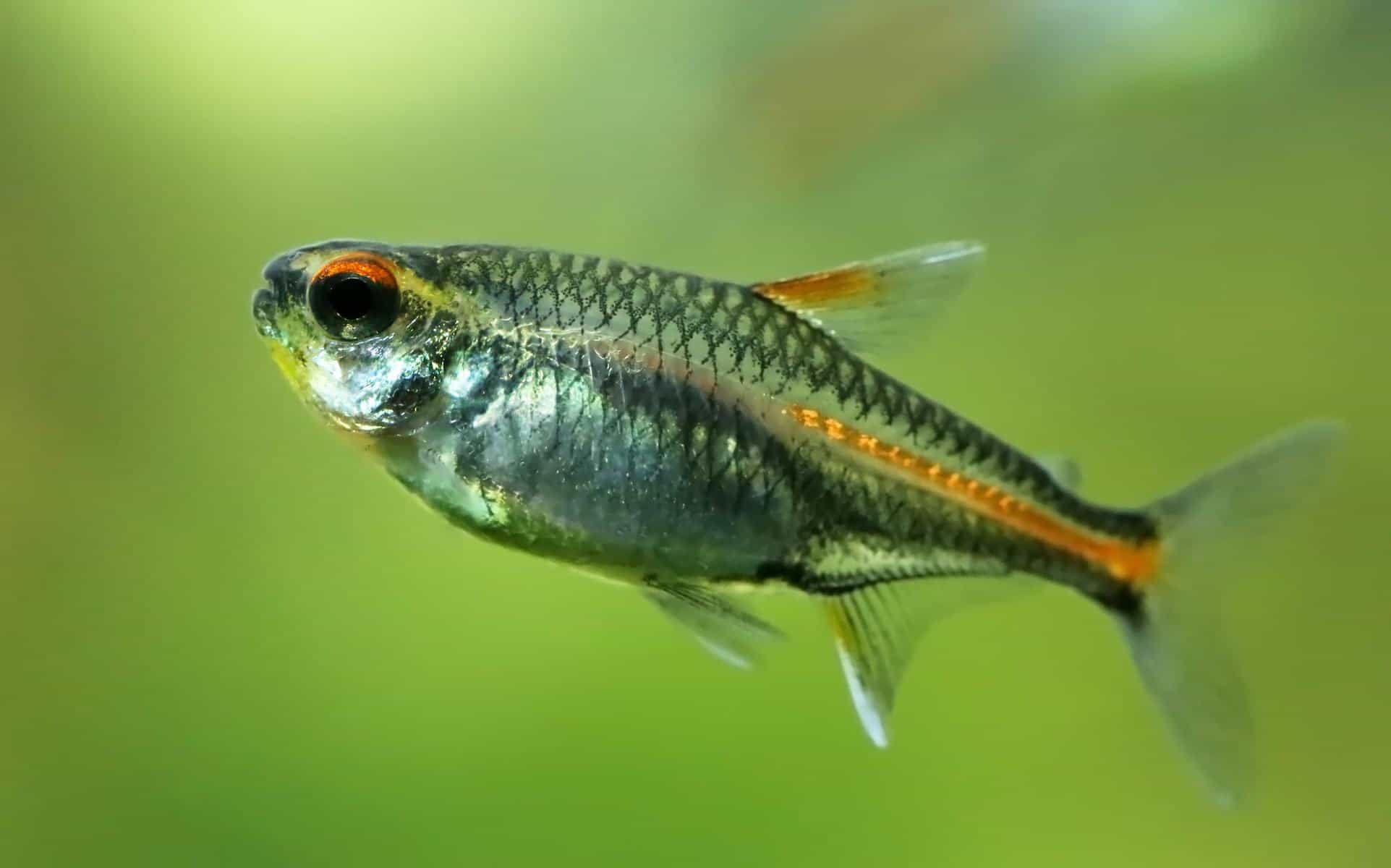
- Care level: Easy
- Temperament: Peaceful
- Tank size: 15 gallons
- Size: 1 inch
- Life expectancy: 3-4 years
The Glowlight Tetra makes a bright, colorful addition to a community tank and offers an alternative to the more commonly seen Cardinal or Neon Tetra, which make excellent mates for the Dwarf Gourami.
Glowlight Tetras are peaceful schooling fish that enjoy similar water and tank conditions to your gouramis. However, you might want to consider adding leaf litter to create a blackwater environment and a few floating plants to diffuse the light, replicating the Glowlight Tetra’s natural habitat.
Like most schooling species, you need to keep a group of at least eight Glowlight Tetras. The security provided by the community will prevent stress, encourage natural behavior, and help enhance their colors.
Amano Shrimp (Caridina multidentata)
- Care level: Easy
- Temperament: Peaceful
- Tank size: 10 gallons
- Size: 1.5 inches
- Life expectancy: 3-4 years
The Amano Shrimp is a peaceful little crustacean that makes a neat addition to the aquarium and is an excellent gourami tank mate, too. These guys are too big to look like lunch to large fish, and their appetite for algae helps keep your tank looking good.
Amanos are very easy to keep. They’re herbivores, so you need to provide them with food in the form of algae wafers and blanched veggies to supplement their primary diet of algae. These shrimp won’t overrun your aquarium either, as they only spawn in brackish water.
Platy (Xiphophorous sp.)
- Care level: Easy
- Temperament: Peaceful
- Tank size: 10 gallons
- Size: 2.8 inches
- Life expectancy: 3-4 years
Platies have been an extremely popular fish among hobbyists for many years. These little fish are peaceful, active, super easy to care for and come in a range of brilliant colors, including gold, red, orange, white, black, purple, and multicolored.
Platies will serve as fine mates for your gouramis, and they share very similar water conditions and dietary requirements, too. As a bonus, Platies are livebearers and prolific spawners, so if you have a group of males and females, you can be sure that you’ll get plenty of fry, too!
Molly (Poecilia sphenops)
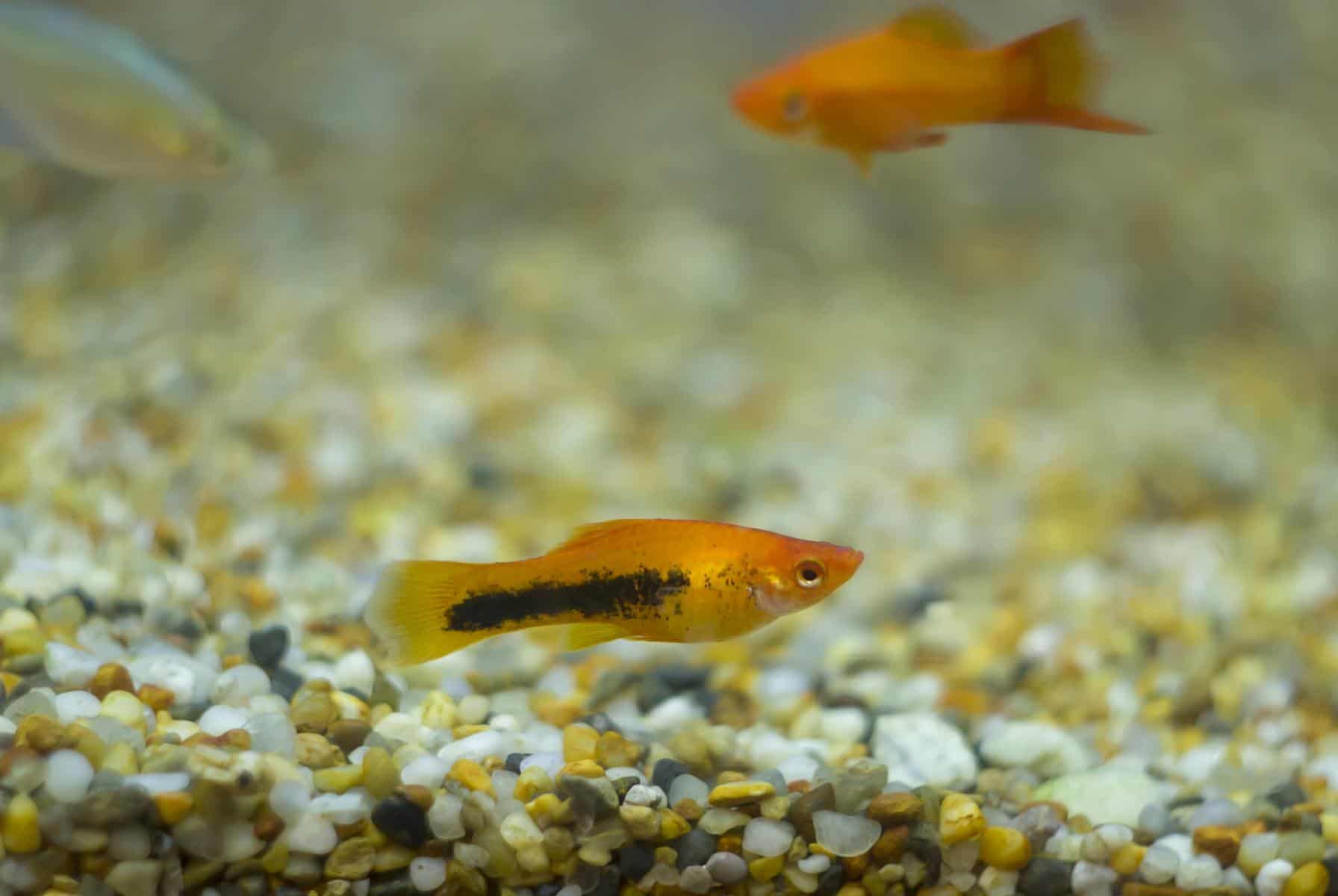
- Care level: Easy
- Temperament: Peaceful
- Tank size: 15 gallons
- Size: 3 inches
- Life expectancy: 3-4 years
Molly fish are another extremely popular home aquarium fish species that lend themselves well to sharing space with gouramis.
The Molly likes similar tank conditions to the gourami and is a hardy species that is perfect for a beginner. Like Platies, Mollies come in a wide range of bright colors and are totally peaceful, making them an ideal community fish. There are many different forms of Mollies, too, so you can keep a mixed school and create a stunning display.
Khuli Loach (Pangio kuhlii)
- Care level: Easy
- Temperament: Peaceful
- Tank size: 20 gallons
- Size: 3 inches
- Life expectancy: up to 14 years
Khuli Loaches are slender, snake-like bottom-dwellers that make great tank mates for gourami and other fish species, too. These stripy fish keep themselves to themselves and are primarily nocturnal, spending much of their time hiding in caves or among plants and emerging at night to feed.
Khuli Loaches should be kept in large groups of eight individuals or more to keep them happy. To view these active fish at play, you might want to consider installing a moonlight. These fish are long-lived creatures, so you’ll get to enjoy them for many years if you look after them properly.
Cherry Barb (Puntius titteya)
- Care level: Easy
- Temperament: Peaceful
- Tank size: 20 gallons
- Size: 2 inches
- Life expectancy: 5-6 years
Although barbs as a family generally get a bad rep for nipping and aggression, Cherry Barbs are the exception. These beautiful, brightly colored little fishes make excellent community fish and a fine tank mate for gourami.
Cherry Barbs are active, hardy little fishes that have similar water preferences to gouramis, although they are very adaptable and can tolerate a range of conditions. You need to keep these fish in a school of at least eight to enjoy their best colors and see them behaving as they would in the wild. Be sure to provide a heavily planted space with plenty of hiding places for these guys.
Chili Rasboras
- Care level: Easy
- Temperament: Peaceful
- Tank size: 10 gallons
- Size: 0.75 inches
- Life expectancy: 5-6 years
Chili Rasboras are tiny nano fish that make a great addition to a community that includes Dwarf Gouramis. These little fishes are brilliantly colored and peaceful creatures, making a wonderful display when kept in a large school of ten or more.
This species enjoys similar water conditions to the Dwarf Gourami and likes a well-planted tank with plenty of places to hide. With their bright, flashy colors, these fish make the perfect contrast to beautiful powder blue Dwarf Gouramis.
Although Chili Rasboras are pretty easy to care for, they do need pristine water conditions, so you will need to pay particular attention to your tank maintenance duties.
Zebra Danios
- Care level: Easy
- Temperament: Peaceful
- Tank size: 10 gallons
- Size: 0.2 inches
- Life expectancy: 3-4 years
The Zebra Danio is a super-cute little fish that looks stunning when kept in a large shoal. Although you can keep these stripy iridescent fish in nano tanks, they are very active and are happier when they have plenty of space for swimming.
Zebra Danios are peaceful community fish that do best in a densely planted tank that also has plenty of room for swimming. Naturally adapted for life in soft water, the highly adaptable danio fits in well in a gourami fish tank.
Otocinclus Catfish
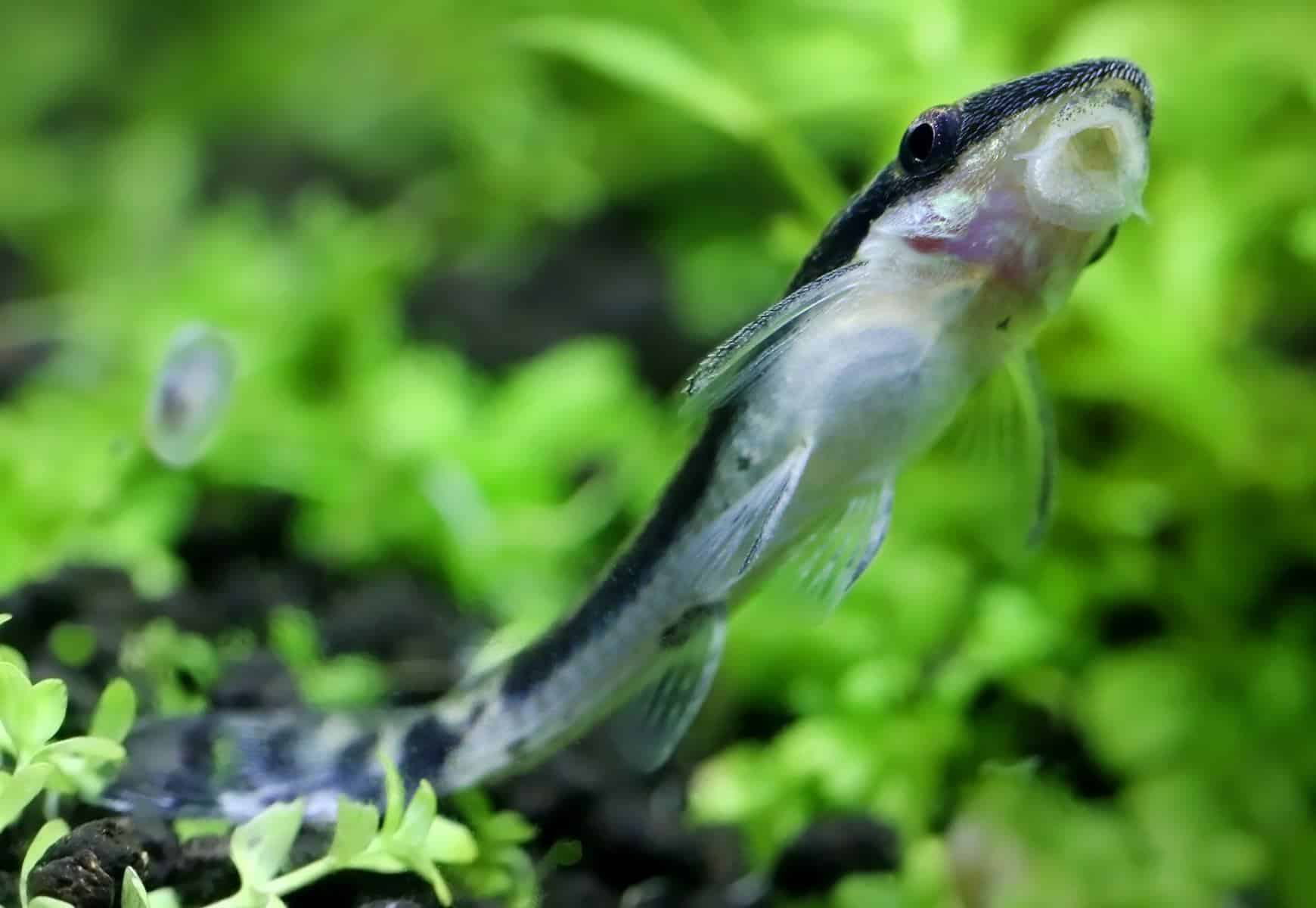
- Care level: Intermediate
- Temperament: Peaceful
- Size: 1-2 inches
- Min tank size: 10 gallons
The Otocinclus Catfish, or Oto Cat, is a tiny bottom-dwelling catfish. These cute, peaceful fish live in schools, feeding exclusively on algae in the wild environment. In the aquarium, the Oto Cat will graze on any algae that it finds growing in your tank, but you will need to supplement that diet with algae wafers and blanched veggies to keep these little herbivores happy and well-fed.
Oto Cats must be kept in groups of five or more individuals. These little guys are typically very active and full of personality, although they’re also peaceful and won’t hassle your gourami. Look out for plump, lively specimens in the fish store and always introduce these fish to an established tank that already has plenty of algae for them to eat.
Final thoughts
The gourami comes in lots of different varieties, most of which are suitable for life in a community tank.
When choosing suitable companions for your gouramis, look for species of peaceful fish and invertebrates that share the same basic water requirements (like acidity and temperature), can eat the same or a similar diet, and are non-aggressive, chilled-out characters. Also, bear in mind the size of your tank versus the size of your fish, and be careful not to overstock your aquarium.

